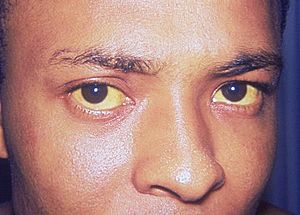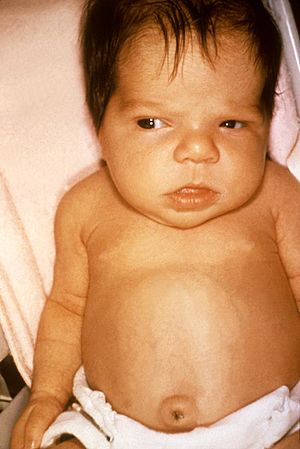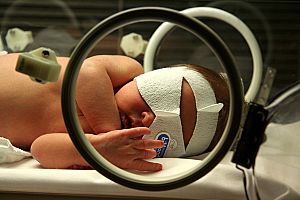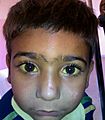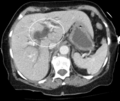Jaundice facts for kids
Quick facts for kids Jaundice |
|
|---|---|
| Synonyms | Icterus |
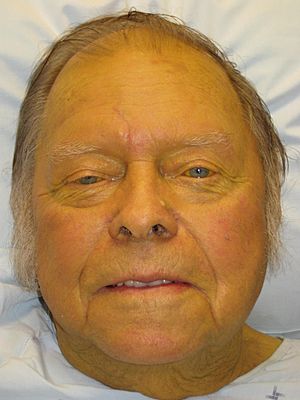 |
|
| Jaundice of the skin caused by pancreatic cancer | |
| Pronunciation |
|
| Symptoms | Yellowish coloration of skin and whites of the eyes, pruritis |
| Causes | High bilirubin levels |
| Diagnostic method | Blood bilirubin, liver panel |
| Similar conditions | Carotenemia, taking rifampin |
| Treatment | Based on the underlying cause |
Jaundice (also called icterus) is a condition where your skin and the whites of your eyes turn a yellow color. This happens because of a problem with your liver. The liver helps clean out old red blood cells from your body. These old blood cells contain a yellow chemical called bilirubin. If the liver isn't working right, too much bilirubin builds up in your blood, causing the yellow color.
Jaundice is very common in newborn babies. It usually appears a couple of days after they are born. Older children and adults can also get jaundice. It can be a sign of other health issues like malaria, hepatitis, or gallstones.
The liver makes a special liquid called bile. Bile is important for digestion and helps your body use nutrients from food. If bile can't flow properly into the intestines, it can cause problems and lead to jaundice.
Contents
What Are the Types of Jaundice?
There are three main types of jaundice, depending on what causes the bilirubin to build up:
- Hemolytic jaundice: This happens when too many red blood cells are destroyed too quickly. This creates a lot of bilirubin, more than the liver can handle. It can also lead to anemia, which means you don't have enough healthy red blood cells.
- Obstructive jaundice: This type occurs when there's a blockage in the tubes (bile ducts) that carry bile from the liver to the duodenum (the first part of the small intestine). This blockage stops bilirubin from leaving the liver.
- Hepatocellular jaundice: This is caused by damage to the liver cells themselves. This damage can come from a viral infection, like hepatitis, or from certain medicines. When liver cells are damaged, they can't process bilirubin properly.
In all these types, the main sign is the yellow color of the skin and the whites of the eyes.
What Are the Symptoms of Jaundice?
If someone has jaundice, they might notice several symptoms. The most obvious one is the yellow color of their eyes, tongue, skin, and even their urine.
Other symptoms can include:
- Feeling very weak or tired
- A headache
- A fever
- Not wanting to eat (loss of appetite)
- Feeling sick to your stomach (nausea)
- Severe constipation
- A dull ache or pain in the area where your liver is (on the right side of your upper belly).
- If you have obstructive jaundice, you might also experience intense itching.
What Causes Jaundice?
Jaundice is a sign that your liver isn't working as it should. It often happens when the bile ducts, which are like tiny pipes that carry bile, get blocked. When these ducts are blocked, bile and bilirubin can't get into the intestines. Instead, they mix with your blood, which causes your skin to turn yellow.
Some common reasons for blocked bile ducts or liver problems that lead to jaundice include:
- Gallstones: These are small, hard deposits that can form in your gallbladder and block the bile ducts.
- Hepatitis: This is when your liver becomes swollen and inflamed, often due to a virus. This virus can spread, especially in places with:
- Lots of people in a small area
- Dirty surroundings
- Unclean conditions
- Contaminated food and water
Other health conditions that can cause jaundice include certain types of anemia and diseases that affect the liver, such as typhoid, malaria, yellow fever, and tuberculosis.
Images for kids
-
A 4-year-old boy with yellow eyes due to G6PD deficiency
See also
 In Spanish: Ictericia para niños
In Spanish: Ictericia para niños


